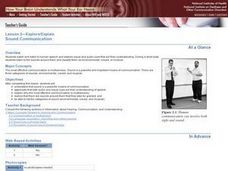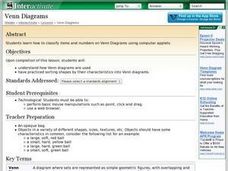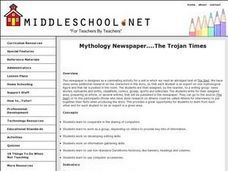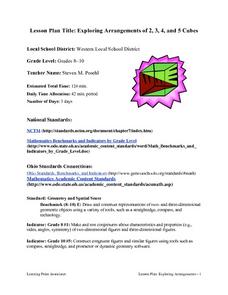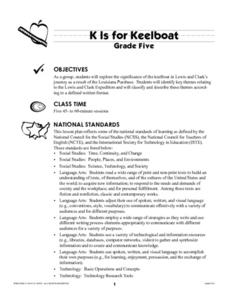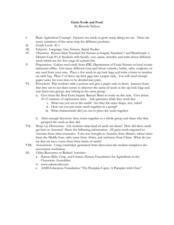Curated OER
WATTS UP?
Second graders research the Internet as they classify different forms of energy, investigate electrical energy and how to conserve energy.
Curated OER
Choosing an Appropriate
Students use the classified ads of a local newspaper and read descriptions of people's goals, interests, experience, and skills, then find an appropriate employment ad for that person. Next, they find an appropriate ad for themselves.
Curated OER
Hyper Book Reports
Fifth graders create a multimedia book report using a tree map to classify the elements fo fiction books.
Curated OER
Geography
Second graders study and review geographical terms for features. They classify those features and locate them on a map. They review geographical features of Tall Tales.
Curated OER
Animals Galore
Third graders use structural characteristics to sort and classify animals into groups.
Curated OER
Introduction to Genealogy
Students investigate their own family's genealogy by conducting oral interviews and doing Internet research. In a series of activities, students acquire inquiry and research skills, develop an appreciation of their heritage, and classify...
Curated OER
Creative Classification
Students create an animal by using physical characteristics to classify that animal in the Linnaean Classification System. This lesson is part of a multi-segmented unit on the diversity of life.
Curated OER
Lesson 2-Explore/Explain Sound Communication
Students watch and listen to human speech and explore visual and audio cues that aid their understanding. During a short walk, students listen to the sounds around them and classify them as environmental, voiced, or musical.
Curated OER
Roles And Functions of Political Players
Pupils name and classify political representatives in the Canadian Parliament. The roles and responsibilities of the political players are examined.
Curated OER
Into the Pond
Seventh graders use a pond to explore macroinvertebrates and other organisms. They use a dichotomous key to classify the organisms and maintain a journal recording their findings.
Curated OER
Venn Diagram Lesson Plan
Students use Venn diagrams in order to classify different objects and numbers. They then use "Venn Diagram Shape sorter" applets on the computer.
Curated OER
Mythology Newspaper....The Trojan Times
Students are assigned to a writing group: news stories, obituaries and births, classifieds, comics, gossip, sports and editorials. The newspaper covers mythological figures in history. This is a very clever, meaningful lesson in mythology!
Curated OER
"how To Think Like an Archaeologist" Suggested Pre-visit Activity for Historic Jamestowne
Students study grocery receipts to simulate the archaeological activity of classifying items. They discuss the receipts as if they were find lists.
Curated OER
Exploring Arrangements of 2, 3, 4, and 5 Cubes
Learners construct models of various tricubes, tetracubes, and pentacubes that are possible, classify n-cubes into different groupings, and draw these figures on isometric dot paper giving true perspective to what they visualize.
Curated OER
Heritage: What Would YOU Take?
Fifth graders classify goods based on their value and decide what they would take with them if they were resettling to a new land. They write an essay defending their choices.
Curated OER
K Is for Keelboat
Fifth graders investigate the significance of the keelboat in the Lewis and Clark expedition. They define the key themes of the expedition and classify them in prescribed format, an ABC book.
Curated OER
Grain Seeds and Food
Young scholars observe the characteristics of different seed types. They classify, sort, name and write about the seeds.
Curated OER
Where Do We Get the Money We Spend?
Young scholars discuss the sources of income for people in their community. They examine why different jobs are paid different wages. They also classify productive resources in the economy.
Curated OER
Cloud Shadows
Students classify clouds as transparent, translucent or opaque. They conduct an experiment to determine the visual opacity of several classroom objects and then conduct further observations of clouds.
Curated OER
Tools Make A Difference
Learners compare and contrast older and newer types and designs of tools, and examine how the change in tools affected life along the river in the book, "A River Ran Wild." They classify the tools for cooking, hunting, farming, and...
Curated OER
Resistance Poetry
Students create a definition for the term resistance. Once a definition has been created, they create a visual image to correlate with their definition. Working in groups, students read several different resistance poems and classify...
Curated OER
Culture Challenge
Students identify and classify characteristics of the four pre-European cultures in Wisconsin. They playing a game about the different characteristics that belong to each of the cultures studied.
Curated OER
Pyramid Play
Learners investigate the concept of the Food Pyramid. They use a game as a tool of discovery in order to classify different types of food in the pyramid. Upon completion of the game the students construct their own models of it.
Curated OER
Basic Safety Practices
Students demonstrate an awareness of how to use basic safety practices accordingly. They classify substances that are safe and unsafe to taste and touch. In groups the students explore different substances and explain how they are safe...
Other popular searches
- Classifying Triangles
- Classifying Quadrilaterals
- Classifying Polygons
- Classifying Organisms
- Classifying Rocks
- Classify and Categorize
- Classify and Categorizing
- Classify Living Things
- Classifying Angles
- Classify Triangles
- Classify 3d Shapes
- Classifying Objects









